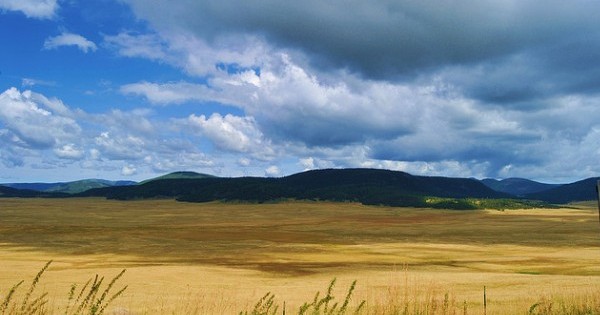Valles Caldera
An ancient wonder is found not far from the atomic era’s birthplace

I have been there. I have stood on its rim. The Valles Caldera is a deep, 12-mile-wide bowl of grassland stretching as far as the eye can see, its grassy vastness punctuated by dome-like forested hills. Last summer, to get there, an old friend and I drove into the Jemez Mountains of north central New Mexico, up the steep and winding Route 4 from Los Alamos. We drove through ponderosa pine forest recovering from the 2011 Las Conchas wildfire, the forest still a scorched landscape with many dead trees, but starting to green up.
We stopped at a lookout and stood at the edge of the caldera—a precipitous drop. The bowl looks like an oversized lake that’s missing its water. A sign installed by the Valles Caldera National Preserve explains that the federal government purchased much of the caldera in 2000 and created the preserve.
Another car drove up, and its occupants got out to look. We were all silent, dumbstruck. After gazing for quite a while I noted some black dots in the distance. They crawled slowly about, buglike.
A debate ensued as to whether we were seeing elk—about 3,000 elk graze the Valles Caldera every summer—or cattle. One observer insisted that these particular dots are cattle because they scattered a bit as they grazed, whereas an elk herd moves this way and that as a unit. What strikes me is how minuscule a large ungulate can look, how vast this montane grassland is. Those domelike hills that dot the caldera are not hills but mountains. One of them, Redondo Peak, reaches 11,254 feet.
What were we looking at?
This landscape is the remains of a volcano that erupted 1.22 million years ago. As the magma of Earth’s mantel rose toward the surface, it broke the rock along a ring fracture, which became the circular rim of the caldera. Then the volcano blew, ejecting 65 cubic miles of magma into the atmosphere. The magma chamber was 300 times as massive as that of Mount St. Helens. With nothing to hold it up, the chamber collapsed, creating the immense pit that is the Valles Caldera.
It was a spectacular event lacking spectators, since it occurred before our species evolved. Volcanic rock of explosive origin formed the upper Bandelier Tuff, in places hundreds of feet thick.
Redondo Peak is a resurgent dome. After the explosion, a huge amount of hot tuff backfilled the immense hole as it was collapsing. The tuff had an eruption temperature of about 1,500 degrees Fahrenheit, and it was about 4,000 feet thick. Hot tuff stayed hot and pushed up Redondo Peak over a period of 30,000 years. (I’m gleaning some of these facts from a handsome little book, Valles Caldera, by geologist Fraser Goff.)
The caldera that now looks like an empty lake was once a real lake, a vast lacustrine container that filled with water from rain and snow. Some 500,000 years ago (still a long time before our species evolved perhaps 200,000 years ago), the lake drained away. By then it had accumulated sediments at the bottom, good soil for grass to grow in.
Down under, it’s still hot. Hot springs and fumaroles (vents hissing steam and hot gas) tell us so.
The Seven Wonders of the World are legendary, but the list has morphed numerous times since the time of Herodotus. My thought is that we should each compile our own list, the seven wonders most wonderful to us. Valles Caldera is not the oldest caldera in the world; nor is it the largest. But I have seen it, and it is a thing of wonder. I hereby dub it one of my Seven Wonders of the World.

